Evaluating Food Production Systems: BTEC HND Hospitality Report
VerifiedAdded on 2023/06/01
|11
|3258
|124
Report
AI Summary
This report provides a comprehensive analysis of various food production and preparation systems within the hospitality industry, focusing on their design and influencing factors. It begins by defining food systems and highlighting the importance of food safety and innovation. The report then explores different food production systems, including traditional, centralized, event catering, and assembly kitchens, detailing their processes and applications. Various food preparation methods such as cook-chill, sous vide, and batch cooking are also examined. Furthermore, the report discusses the key influences on the design of food preparation and production systems, considering factors such as equipment type, storage requirements, cost considerations, kitchen purpose, ventilation, and maintenance. The conclusion emphasizes the importance of understanding these systems to optimize efficiency, productivity, and cost-effectiveness in food production businesses. This assignment solution is available on Desklib, a platform offering a wide range of study resources including past papers and solved assignments for students.
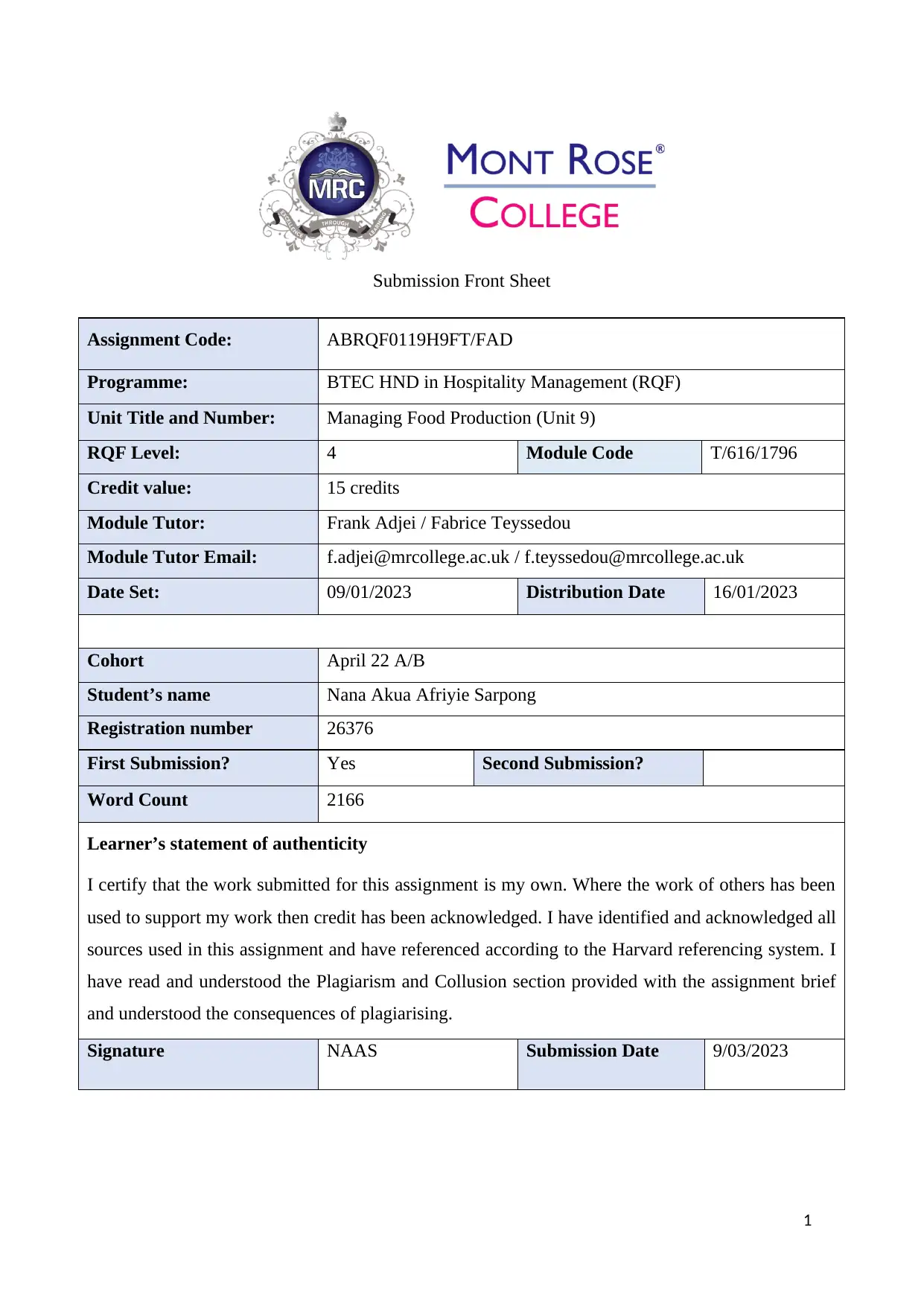
Submission Front Sheet
Assignment Code: ABRQF0119H9FT/FAD
Programme: BTEC HND in Hospitality Management (RQF)
Unit Title and Number: Managing Food Production (Unit 9)
RQF Level: 4 Module Code T/616/1796
Credit value: 15 credits
Module Tutor: Frank Adjei / Fabrice Teyssedou
Module Tutor Email: f.adjei@mrcollege.ac.uk / f.teyssedou@mrcollege.ac.uk
Date Set: 09/01/2023 Distribution Date 16/01/2023
Cohort April 22 A/B
Student’s name Nana Akua Afriyie Sarpong
Registration number 26376
First Submission? Yes Second Submission?
Word Count 2166
Learner’s statement of authenticity
I certify that the work submitted for this assignment is my own. Where the work of others has been
used to support my work then credit has been acknowledged. I have identified and acknowledged all
sources used in this assignment and have referenced according to the Harvard referencing system. I
have read and understood the Plagiarism and Collusion section provided with the assignment brief
and understood the consequences of plagiarising.
Signature NAAS Submission Date 9/03/2023
1
Assignment Code: ABRQF0119H9FT/FAD
Programme: BTEC HND in Hospitality Management (RQF)
Unit Title and Number: Managing Food Production (Unit 9)
RQF Level: 4 Module Code T/616/1796
Credit value: 15 credits
Module Tutor: Frank Adjei / Fabrice Teyssedou
Module Tutor Email: f.adjei@mrcollege.ac.uk / f.teyssedou@mrcollege.ac.uk
Date Set: 09/01/2023 Distribution Date 16/01/2023
Cohort April 22 A/B
Student’s name Nana Akua Afriyie Sarpong
Registration number 26376
First Submission? Yes Second Submission?
Word Count 2166
Learner’s statement of authenticity
I certify that the work submitted for this assignment is my own. Where the work of others has been
used to support my work then credit has been acknowledged. I have identified and acknowledged all
sources used in this assignment and have referenced according to the Harvard referencing system. I
have read and understood the Plagiarism and Collusion section provided with the assignment brief
and understood the consequences of plagiarising.
Signature NAAS Submission Date 9/03/2023
1
Paraphrase This Document
Need a fresh take? Get an instant paraphrase of this document with our AI Paraphraser
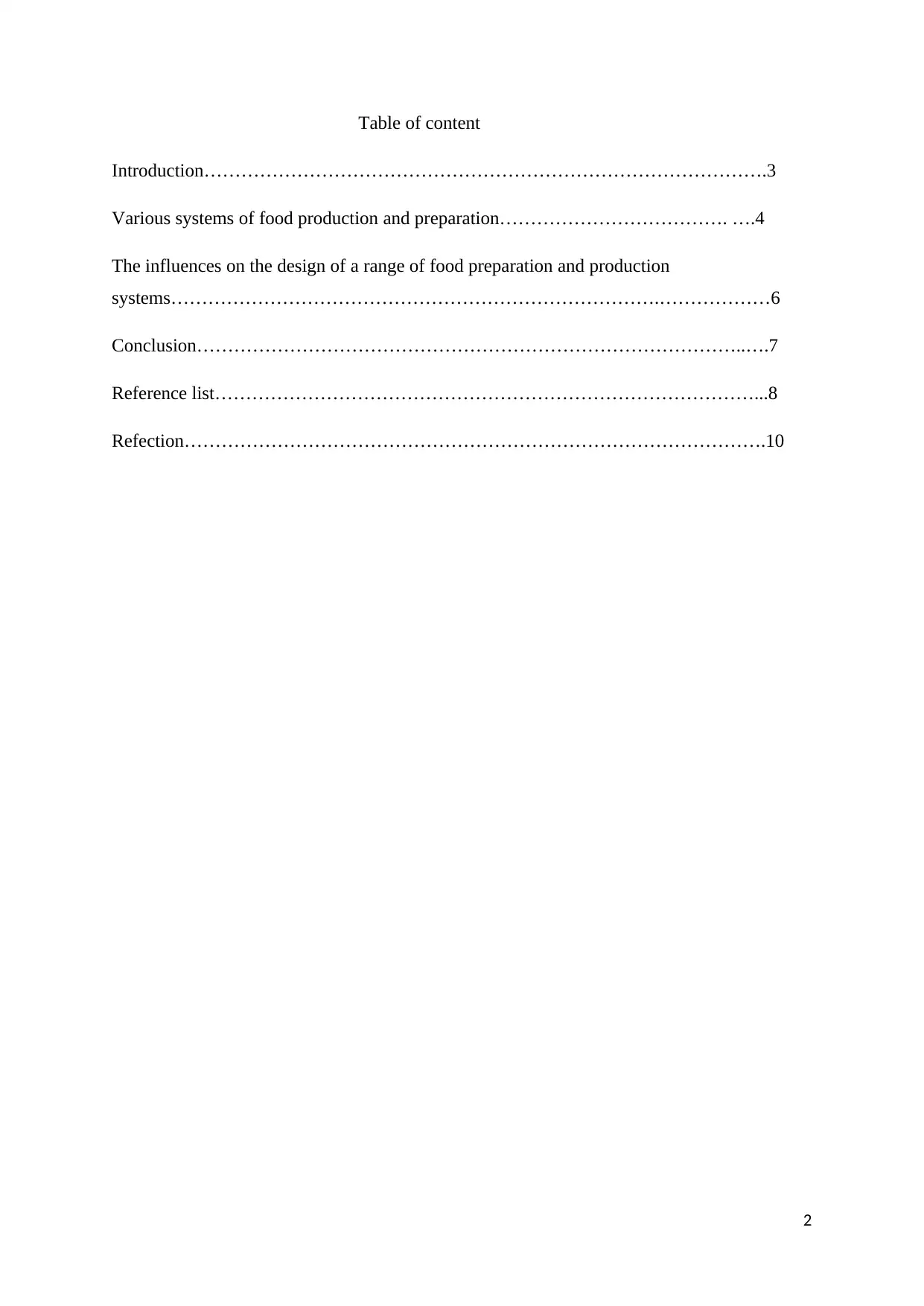
Table of content
Introduction……………………………………………………………………………….3
Various systems of food production and preparation………………………………. ….4
The influences on the design of a range of food preparation and production
systems…………………………………………………………………….………………6
Conclusion……………………………………………………………………………..….7
Reference list……………………………………………………………………………...8
Refection………………………………………………………………………………….10
2
Introduction……………………………………………………………………………….3
Various systems of food production and preparation………………………………. ….4
The influences on the design of a range of food preparation and production
systems…………………………………………………………………….………………6
Conclusion……………………………………………………………………………..….7
Reference list……………………………………………………………………………...8
Refection………………………………………………………………………………….10
2
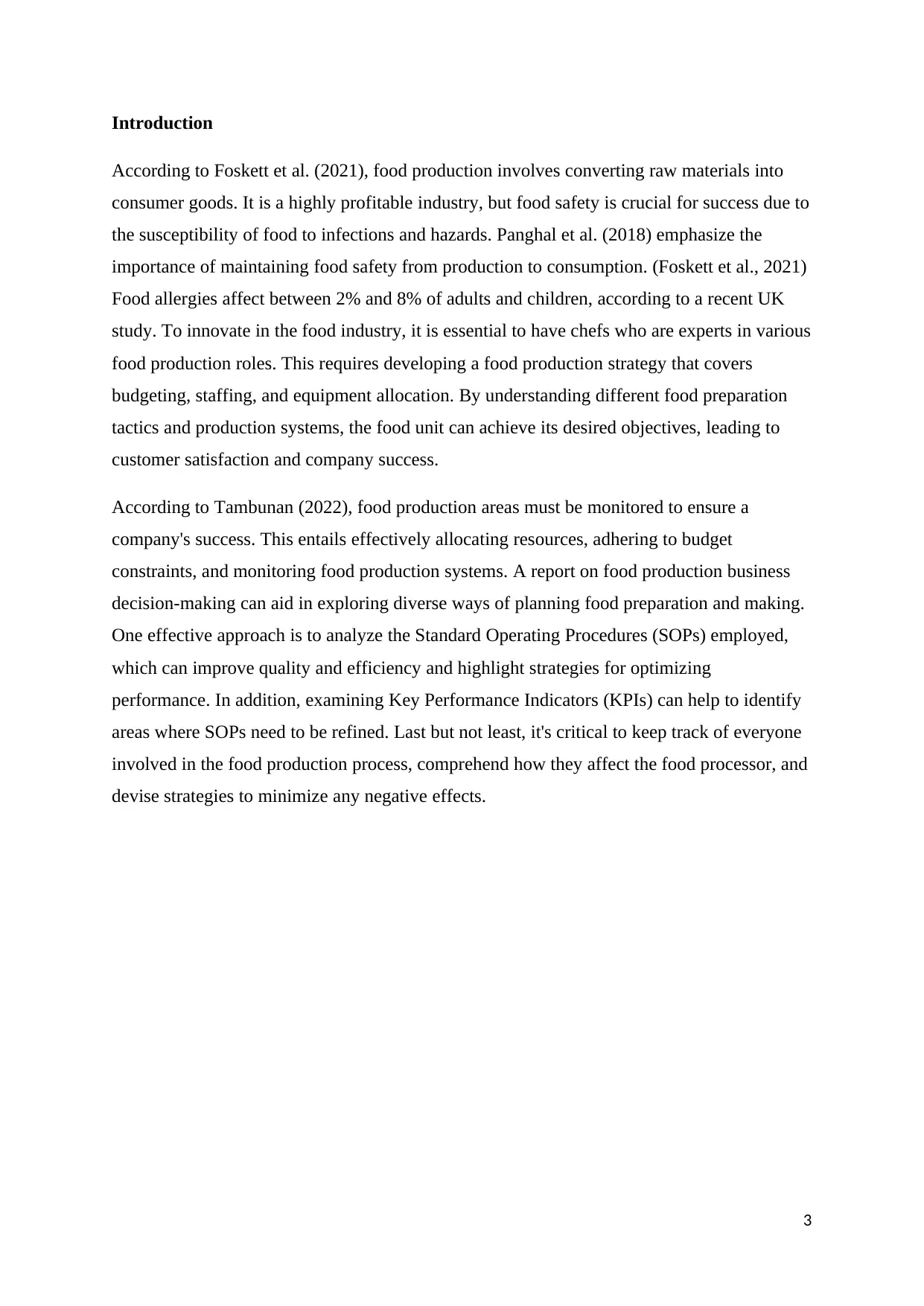
Introduction
According to Foskett et al. (2021), food production involves converting raw materials into
consumer goods. It is a highly profitable industry, but food safety is crucial for success due to
the susceptibility of food to infections and hazards. Panghal et al. (2018) emphasize the
importance of maintaining food safety from production to consumption. (Foskett et al., 2021)
Food allergies affect between 2% and 8% of adults and children, according to a recent UK
study. To innovate in the food industry, it is essential to have chefs who are experts in various
food production roles. This requires developing a food production strategy that covers
budgeting, staffing, and equipment allocation. By understanding different food preparation
tactics and production systems, the food unit can achieve its desired objectives, leading to
customer satisfaction and company success.
According to Tambunan (2022), food production areas must be monitored to ensure a
company's success. This entails effectively allocating resources, adhering to budget
constraints, and monitoring food production systems. A report on food production business
decision-making can aid in exploring diverse ways of planning food preparation and making.
One effective approach is to analyze the Standard Operating Procedures (SOPs) employed,
which can improve quality and efficiency and highlight strategies for optimizing
performance. In addition, examining Key Performance Indicators (KPIs) can help to identify
areas where SOPs need to be refined. Last but not least, it's critical to keep track of everyone
involved in the food production process, comprehend how they affect the food processor, and
devise strategies to minimize any negative effects.
3
According to Foskett et al. (2021), food production involves converting raw materials into
consumer goods. It is a highly profitable industry, but food safety is crucial for success due to
the susceptibility of food to infections and hazards. Panghal et al. (2018) emphasize the
importance of maintaining food safety from production to consumption. (Foskett et al., 2021)
Food allergies affect between 2% and 8% of adults and children, according to a recent UK
study. To innovate in the food industry, it is essential to have chefs who are experts in various
food production roles. This requires developing a food production strategy that covers
budgeting, staffing, and equipment allocation. By understanding different food preparation
tactics and production systems, the food unit can achieve its desired objectives, leading to
customer satisfaction and company success.
According to Tambunan (2022), food production areas must be monitored to ensure a
company's success. This entails effectively allocating resources, adhering to budget
constraints, and monitoring food production systems. A report on food production business
decision-making can aid in exploring diverse ways of planning food preparation and making.
One effective approach is to analyze the Standard Operating Procedures (SOPs) employed,
which can improve quality and efficiency and highlight strategies for optimizing
performance. In addition, examining Key Performance Indicators (KPIs) can help to identify
areas where SOPs need to be refined. Last but not least, it's critical to keep track of everyone
involved in the food production process, comprehend how they affect the food processor, and
devise strategies to minimize any negative effects.
3
⊘ This is a preview!⊘
Do you want full access?
Subscribe today to unlock all pages.

Trusted by 1+ million students worldwide
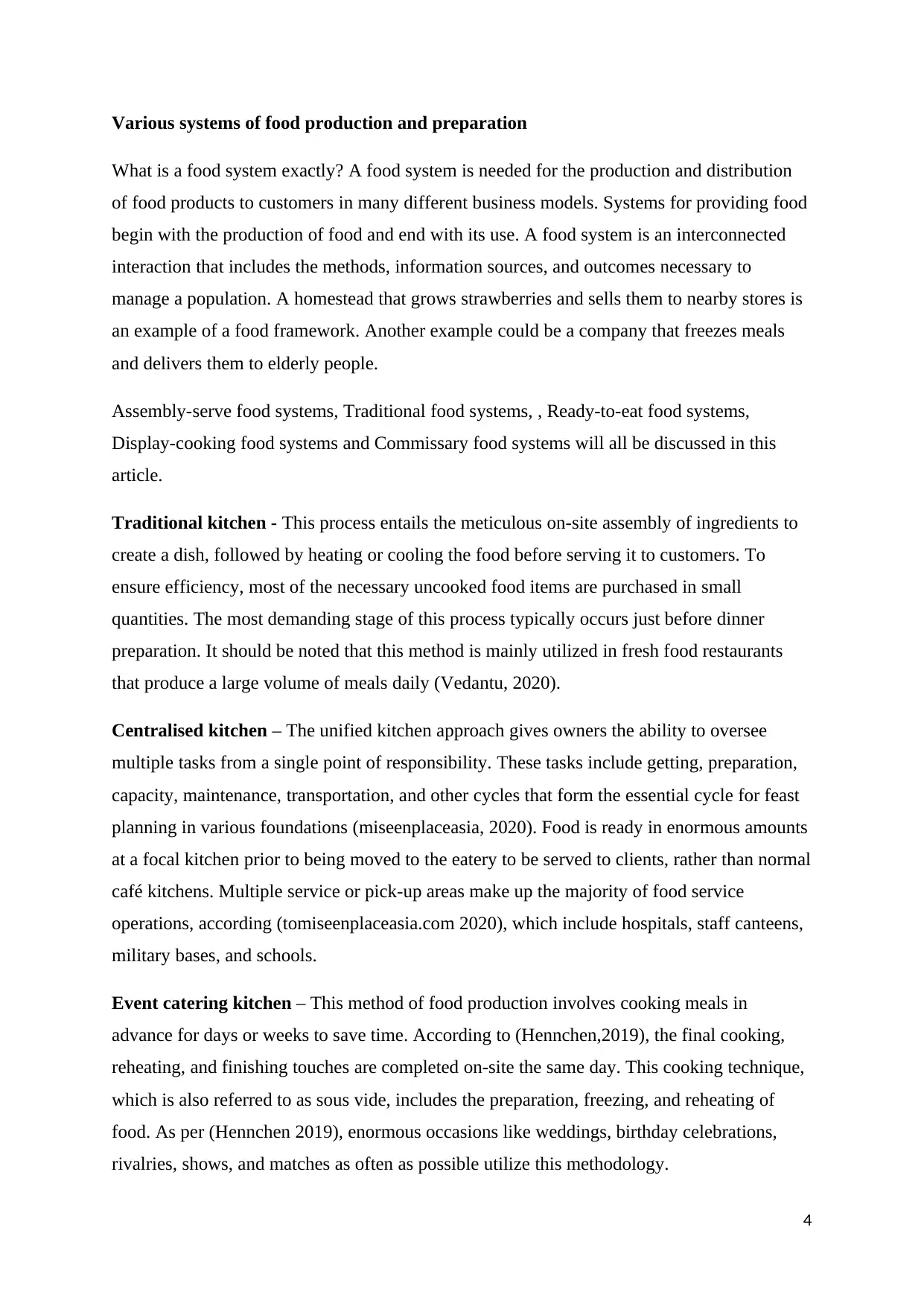
Various systems of food production and preparation
What is a food system exactly? A food system is needed for the production and distribution
of food products to customers in many different business models. Systems for providing food
begin with the production of food and end with its use. A food system is an interconnected
interaction that includes the methods, information sources, and outcomes necessary to
manage a population. A homestead that grows strawberries and sells them to nearby stores is
an example of a food framework. Another example could be a company that freezes meals
and delivers them to elderly people.
Assembly-serve food systems, Traditional food systems, , Ready-to-eat food systems,
Display-cooking food systems and Commissary food systems will all be discussed in this
article.
Traditional kitchen - This process entails the meticulous on-site assembly of ingredients to
create a dish, followed by heating or cooling the food before serving it to customers. To
ensure efficiency, most of the necessary uncooked food items are purchased in small
quantities. The most demanding stage of this process typically occurs just before dinner
preparation. It should be noted that this method is mainly utilized in fresh food restaurants
that produce a large volume of meals daily (Vedantu, 2020).
Centralised kitchen – The unified kitchen approach gives owners the ability to oversee
multiple tasks from a single point of responsibility. These tasks include getting, preparation,
capacity, maintenance, transportation, and other cycles that form the essential cycle for feast
planning in various foundations (miseenplaceasia, 2020). Food is ready in enormous amounts
at a focal kitchen prior to being moved to the eatery to be served to clients, rather than normal
café kitchens. Multiple service or pick-up areas make up the majority of food service
operations, according (tomiseenplaceasia.com 2020), which include hospitals, staff canteens,
military bases, and schools.
Event catering kitchen – This method of food production involves cooking meals in
advance for days or weeks to save time. According to (Hennchen,2019), the final cooking,
reheating, and finishing touches are completed on-site the same day. This cooking technique,
which is also referred to as sous vide, includes the preparation, freezing, and reheating of
food. As per (Hennchen 2019), enormous occasions like weddings, birthday celebrations,
rivalries, shows, and matches as often as possible utilize this methodology.
4
What is a food system exactly? A food system is needed for the production and distribution
of food products to customers in many different business models. Systems for providing food
begin with the production of food and end with its use. A food system is an interconnected
interaction that includes the methods, information sources, and outcomes necessary to
manage a population. A homestead that grows strawberries and sells them to nearby stores is
an example of a food framework. Another example could be a company that freezes meals
and delivers them to elderly people.
Assembly-serve food systems, Traditional food systems, , Ready-to-eat food systems,
Display-cooking food systems and Commissary food systems will all be discussed in this
article.
Traditional kitchen - This process entails the meticulous on-site assembly of ingredients to
create a dish, followed by heating or cooling the food before serving it to customers. To
ensure efficiency, most of the necessary uncooked food items are purchased in small
quantities. The most demanding stage of this process typically occurs just before dinner
preparation. It should be noted that this method is mainly utilized in fresh food restaurants
that produce a large volume of meals daily (Vedantu, 2020).
Centralised kitchen – The unified kitchen approach gives owners the ability to oversee
multiple tasks from a single point of responsibility. These tasks include getting, preparation,
capacity, maintenance, transportation, and other cycles that form the essential cycle for feast
planning in various foundations (miseenplaceasia, 2020). Food is ready in enormous amounts
at a focal kitchen prior to being moved to the eatery to be served to clients, rather than normal
café kitchens. Multiple service or pick-up areas make up the majority of food service
operations, according (tomiseenplaceasia.com 2020), which include hospitals, staff canteens,
military bases, and schools.
Event catering kitchen – This method of food production involves cooking meals in
advance for days or weeks to save time. According to (Hennchen,2019), the final cooking,
reheating, and finishing touches are completed on-site the same day. This cooking technique,
which is also referred to as sous vide, includes the preparation, freezing, and reheating of
food. As per (Hennchen 2019), enormous occasions like weddings, birthday celebrations,
rivalries, shows, and matches as often as possible utilize this methodology.
4
Paraphrase This Document
Need a fresh take? Get an instant paraphrase of this document with our AI Paraphraser
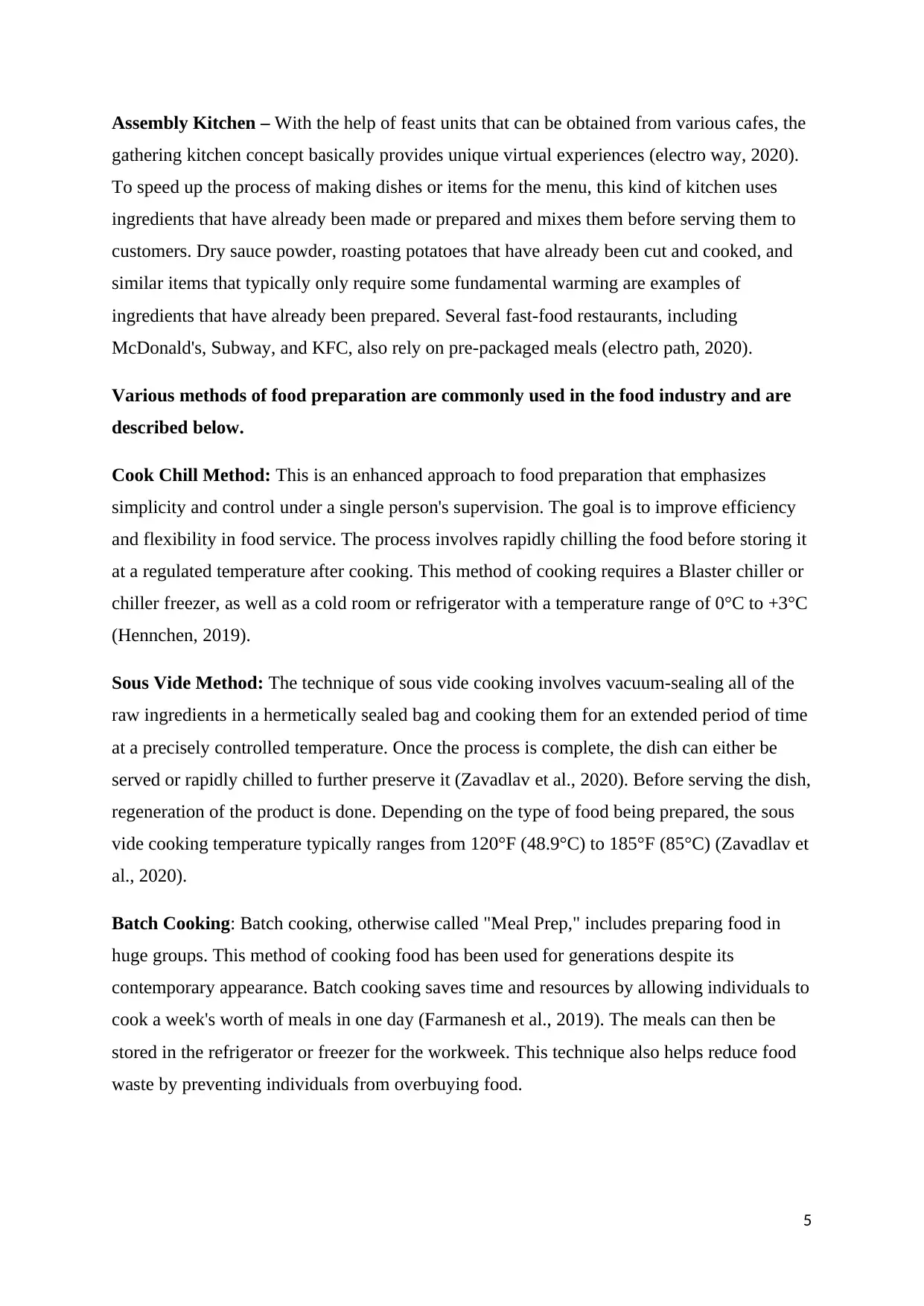
Assembly Kitchen – With the help of feast units that can be obtained from various cafes, the
gathering kitchen concept basically provides unique virtual experiences (electro way, 2020).
To speed up the process of making dishes or items for the menu, this kind of kitchen uses
ingredients that have already been made or prepared and mixes them before serving them to
customers. Dry sauce powder, roasting potatoes that have already been cut and cooked, and
similar items that typically only require some fundamental warming are examples of
ingredients that have already been prepared. Several fast-food restaurants, including
McDonald's, Subway, and KFC, also rely on pre-packaged meals (electro path, 2020).
Various methods of food preparation are commonly used in the food industry and are
described below.
Cook Chill Method: This is an enhanced approach to food preparation that emphasizes
simplicity and control under a single person's supervision. The goal is to improve efficiency
and flexibility in food service. The process involves rapidly chilling the food before storing it
at a regulated temperature after cooking. This method of cooking requires a Blaster chiller or
chiller freezer, as well as a cold room or refrigerator with a temperature range of 0°C to +3°C
(Hennchen, 2019).
Sous Vide Method: The technique of sous vide cooking involves vacuum-sealing all of the
raw ingredients in a hermetically sealed bag and cooking them for an extended period of time
at a precisely controlled temperature. Once the process is complete, the dish can either be
served or rapidly chilled to further preserve it (Zavadlav et al., 2020). Before serving the dish,
regeneration of the product is done. Depending on the type of food being prepared, the sous
vide cooking temperature typically ranges from 120°F (48.9°C) to 185°F (85°C) (Zavadlav et
al., 2020).
Batch Cooking: Batch cooking, otherwise called "Meal Prep," includes preparing food in
huge groups. This method of cooking food has been used for generations despite its
contemporary appearance. Batch cooking saves time and resources by allowing individuals to
cook a week's worth of meals in one day (Farmanesh et al., 2019). The meals can then be
stored in the refrigerator or freezer for the workweek. This technique also helps reduce food
waste by preventing individuals from overbuying food.
5
gathering kitchen concept basically provides unique virtual experiences (electro way, 2020).
To speed up the process of making dishes or items for the menu, this kind of kitchen uses
ingredients that have already been made or prepared and mixes them before serving them to
customers. Dry sauce powder, roasting potatoes that have already been cut and cooked, and
similar items that typically only require some fundamental warming are examples of
ingredients that have already been prepared. Several fast-food restaurants, including
McDonald's, Subway, and KFC, also rely on pre-packaged meals (electro path, 2020).
Various methods of food preparation are commonly used in the food industry and are
described below.
Cook Chill Method: This is an enhanced approach to food preparation that emphasizes
simplicity and control under a single person's supervision. The goal is to improve efficiency
and flexibility in food service. The process involves rapidly chilling the food before storing it
at a regulated temperature after cooking. This method of cooking requires a Blaster chiller or
chiller freezer, as well as a cold room or refrigerator with a temperature range of 0°C to +3°C
(Hennchen, 2019).
Sous Vide Method: The technique of sous vide cooking involves vacuum-sealing all of the
raw ingredients in a hermetically sealed bag and cooking them for an extended period of time
at a precisely controlled temperature. Once the process is complete, the dish can either be
served or rapidly chilled to further preserve it (Zavadlav et al., 2020). Before serving the dish,
regeneration of the product is done. Depending on the type of food being prepared, the sous
vide cooking temperature typically ranges from 120°F (48.9°C) to 185°F (85°C) (Zavadlav et
al., 2020).
Batch Cooking: Batch cooking, otherwise called "Meal Prep," includes preparing food in
huge groups. This method of cooking food has been used for generations despite its
contemporary appearance. Batch cooking saves time and resources by allowing individuals to
cook a week's worth of meals in one day (Farmanesh et al., 2019). The meals can then be
stored in the refrigerator or freezer for the workweek. This technique also helps reduce food
waste by preventing individuals from overbuying food.
5
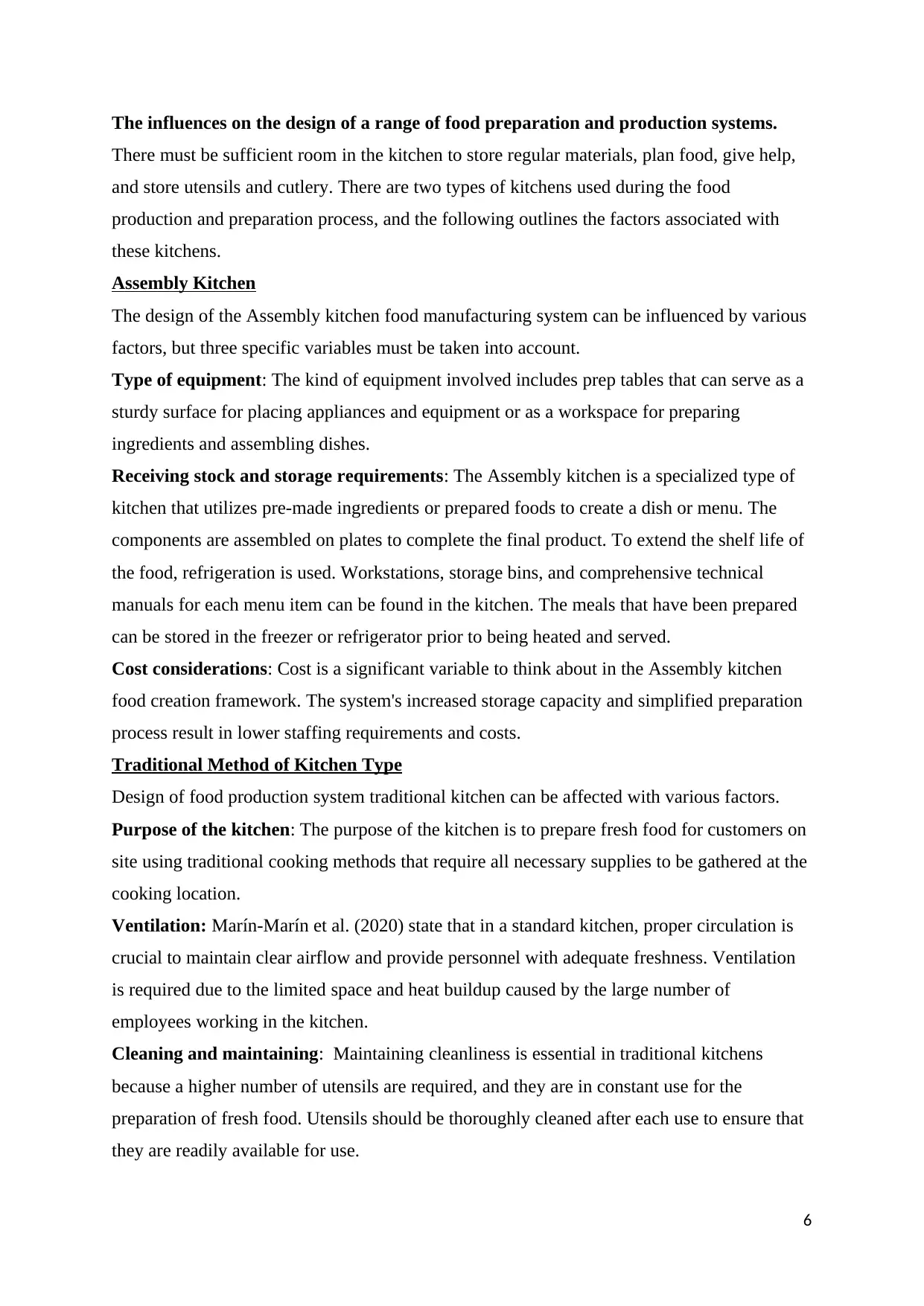
The influences on the design of a range of food preparation and production systems.
There must be sufficient room in the kitchen to store regular materials, plan food, give help,
and store utensils and cutlery. There are two types of kitchens used during the food
production and preparation process, and the following outlines the factors associated with
these kitchens.
Assembly Kitchen
The design of the Assembly kitchen food manufacturing system can be influenced by various
factors, but three specific variables must be taken into account.
Type of equipment: The kind of equipment involved includes prep tables that can serve as a
sturdy surface for placing appliances and equipment or as a workspace for preparing
ingredients and assembling dishes.
Receiving stock and storage requirements: The Assembly kitchen is a specialized type of
kitchen that utilizes pre-made ingredients or prepared foods to create a dish or menu. The
components are assembled on plates to complete the final product. To extend the shelf life of
the food, refrigeration is used. Workstations, storage bins, and comprehensive technical
manuals for each menu item can be found in the kitchen. The meals that have been prepared
can be stored in the freezer or refrigerator prior to being heated and served.
Cost considerations: Cost is a significant variable to think about in the Assembly kitchen
food creation framework. The system's increased storage capacity and simplified preparation
process result in lower staffing requirements and costs.
Traditional Method of Kitchen Type
Design of food production system traditional kitchen can be affected with various factors.
Purpose of the kitchen: The purpose of the kitchen is to prepare fresh food for customers on
site using traditional cooking methods that require all necessary supplies to be gathered at the
cooking location.
Ventilation: Marín-Marín et al. (2020) state that in a standard kitchen, proper circulation is
crucial to maintain clear airflow and provide personnel with adequate freshness. Ventilation
is required due to the limited space and heat buildup caused by the large number of
employees working in the kitchen.
Cleaning and maintaining: Maintaining cleanliness is essential in traditional kitchens
because a higher number of utensils are required, and they are in constant use for the
preparation of fresh food. Utensils should be thoroughly cleaned after each use to ensure that
they are readily available for use.
6
There must be sufficient room in the kitchen to store regular materials, plan food, give help,
and store utensils and cutlery. There are two types of kitchens used during the food
production and preparation process, and the following outlines the factors associated with
these kitchens.
Assembly Kitchen
The design of the Assembly kitchen food manufacturing system can be influenced by various
factors, but three specific variables must be taken into account.
Type of equipment: The kind of equipment involved includes prep tables that can serve as a
sturdy surface for placing appliances and equipment or as a workspace for preparing
ingredients and assembling dishes.
Receiving stock and storage requirements: The Assembly kitchen is a specialized type of
kitchen that utilizes pre-made ingredients or prepared foods to create a dish or menu. The
components are assembled on plates to complete the final product. To extend the shelf life of
the food, refrigeration is used. Workstations, storage bins, and comprehensive technical
manuals for each menu item can be found in the kitchen. The meals that have been prepared
can be stored in the freezer or refrigerator prior to being heated and served.
Cost considerations: Cost is a significant variable to think about in the Assembly kitchen
food creation framework. The system's increased storage capacity and simplified preparation
process result in lower staffing requirements and costs.
Traditional Method of Kitchen Type
Design of food production system traditional kitchen can be affected with various factors.
Purpose of the kitchen: The purpose of the kitchen is to prepare fresh food for customers on
site using traditional cooking methods that require all necessary supplies to be gathered at the
cooking location.
Ventilation: Marín-Marín et al. (2020) state that in a standard kitchen, proper circulation is
crucial to maintain clear airflow and provide personnel with adequate freshness. Ventilation
is required due to the limited space and heat buildup caused by the large number of
employees working in the kitchen.
Cleaning and maintaining: Maintaining cleanliness is essential in traditional kitchens
because a higher number of utensils are required, and they are in constant use for the
preparation of fresh food. Utensils should be thoroughly cleaned after each use to ensure that
they are readily available for use.
6
⊘ This is a preview!⊘
Do you want full access?
Subscribe today to unlock all pages.

Trusted by 1+ million students worldwide
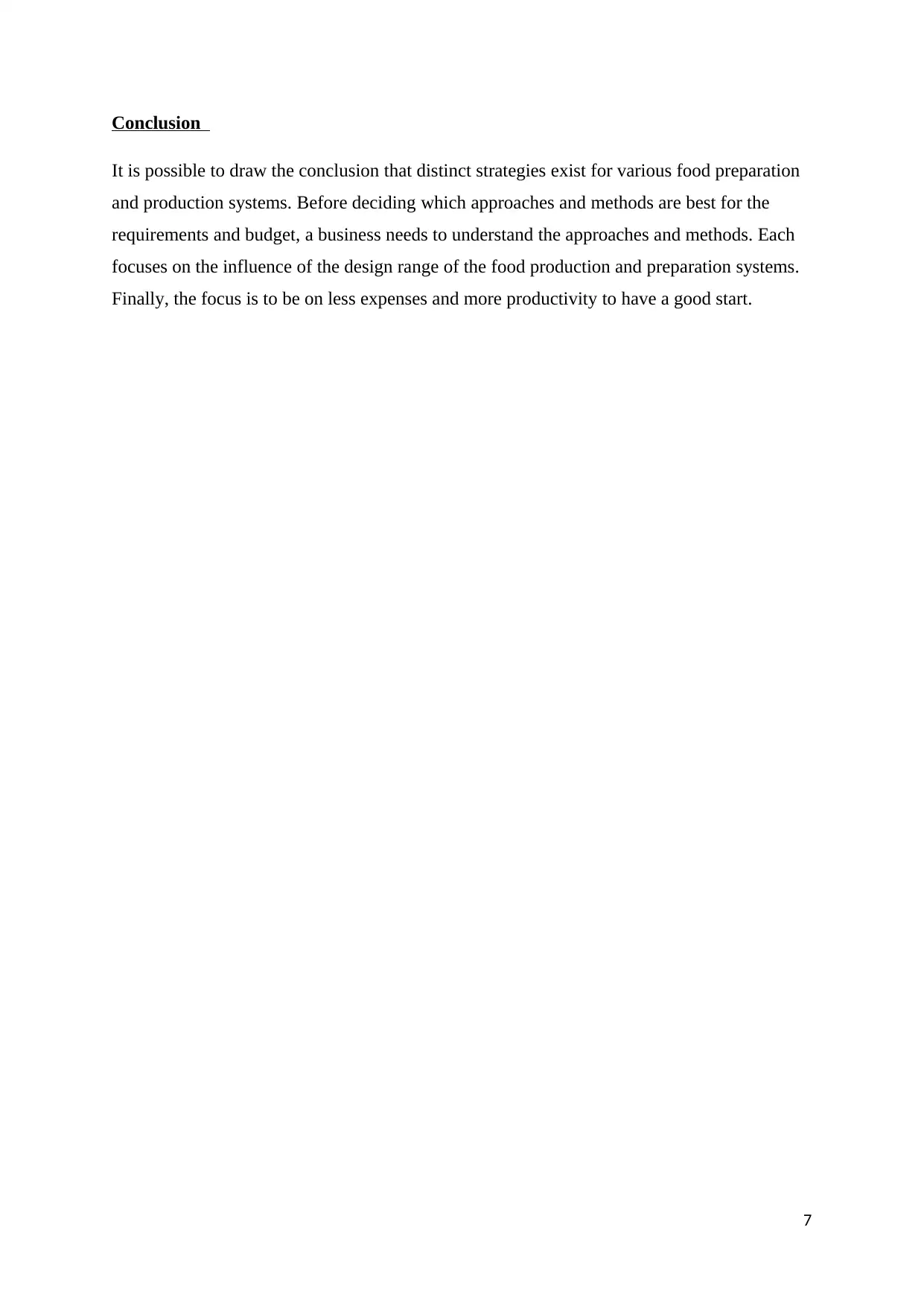
Conclusion
It is possible to draw the conclusion that distinct strategies exist for various food preparation
and production systems. Before deciding which approaches and methods are best for the
requirements and budget, a business needs to understand the approaches and methods. Each
focuses on the influence of the design range of the food production and preparation systems.
Finally, the focus is to be on less expenses and more productivity to have a good start.
7
It is possible to draw the conclusion that distinct strategies exist for various food preparation
and production systems. Before deciding which approaches and methods are best for the
requirements and budget, a business needs to understand the approaches and methods. Each
focuses on the influence of the design range of the food production and preparation systems.
Finally, the focus is to be on less expenses and more productivity to have a good start.
7
Paraphrase This Document
Need a fresh take? Get an instant paraphrase of this document with our AI Paraphraser
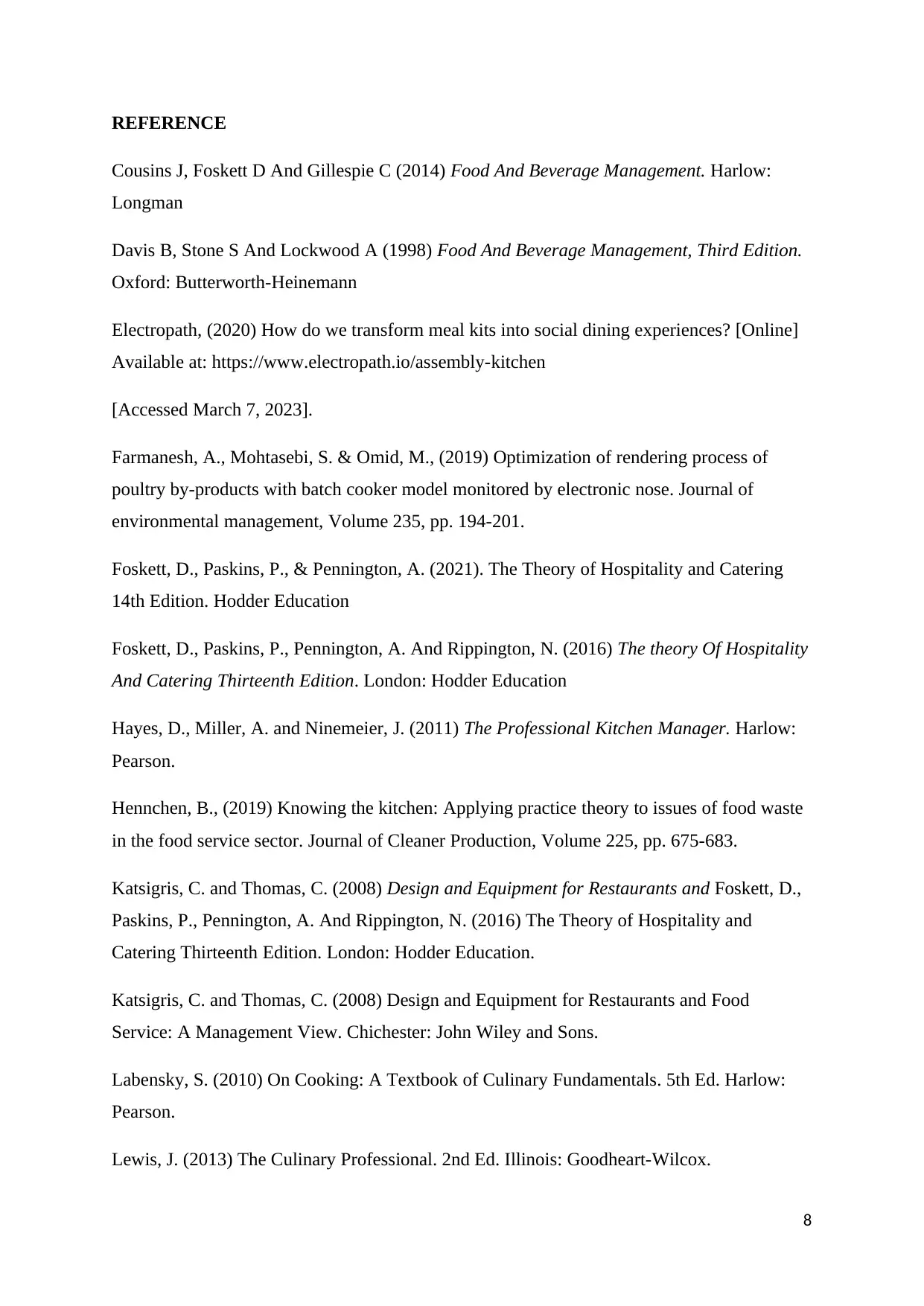
REFERENCE
Cousins J, Foskett D And Gillespie C (2014) Food And Beverage Management. Harlow:
Longman
Davis B, Stone S And Lockwood A (1998) Food And Beverage Management, Third Edition.
Oxford: Butterworth-Heinemann
Electropath, (2020) How do we transform meal kits into social dining experiences? [Online]
Available at: https://www.electropath.io/assembly-kitchen
[Accessed March 7, 2023].
Farmanesh, A., Mohtasebi, S. & Omid, M., (2019) Optimization of rendering process of
poultry by-products with batch cooker model monitored by electronic nose. Journal of
environmental management, Volume 235, pp. 194-201.
Foskett, D., Paskins, P., & Pennington, A. (2021). The Theory of Hospitality and Catering
14th Edition. Hodder Education
Foskett, D., Paskins, P., Pennington, A. And Rippington, N. (2016) The theory Of Hospitality
And Catering Thirteenth Edition. London: Hodder Education
Hayes, D., Miller, A. and Ninemeier, J. (2011) The Professional Kitchen Manager. Harlow:
Pearson.
Hennchen, B., (2019) Knowing the kitchen: Applying practice theory to issues of food waste
in the food service sector. Journal of Cleaner Production, Volume 225, pp. 675-683.
Katsigris, C. and Thomas, C. (2008) Design and Equipment for Restaurants and Foskett, D.,
Paskins, P., Pennington, A. And Rippington, N. (2016) The Theory of Hospitality and
Catering Thirteenth Edition. London: Hodder Education.
Katsigris, C. and Thomas, C. (2008) Design and Equipment for Restaurants and Food
Service: A Management View. Chichester: John Wiley and Sons.
Labensky, S. (2010) On Cooking: A Textbook of Culinary Fundamentals. 5th Ed. Harlow:
Pearson.
Lewis, J. (2013) The Culinary Professional. 2nd Ed. Illinois: Goodheart-Wilcox.
8
Cousins J, Foskett D And Gillespie C (2014) Food And Beverage Management. Harlow:
Longman
Davis B, Stone S And Lockwood A (1998) Food And Beverage Management, Third Edition.
Oxford: Butterworth-Heinemann
Electropath, (2020) How do we transform meal kits into social dining experiences? [Online]
Available at: https://www.electropath.io/assembly-kitchen
[Accessed March 7, 2023].
Farmanesh, A., Mohtasebi, S. & Omid, M., (2019) Optimization of rendering process of
poultry by-products with batch cooker model monitored by electronic nose. Journal of
environmental management, Volume 235, pp. 194-201.
Foskett, D., Paskins, P., & Pennington, A. (2021). The Theory of Hospitality and Catering
14th Edition. Hodder Education
Foskett, D., Paskins, P., Pennington, A. And Rippington, N. (2016) The theory Of Hospitality
And Catering Thirteenth Edition. London: Hodder Education
Hayes, D., Miller, A. and Ninemeier, J. (2011) The Professional Kitchen Manager. Harlow:
Pearson.
Hennchen, B., (2019) Knowing the kitchen: Applying practice theory to issues of food waste
in the food service sector. Journal of Cleaner Production, Volume 225, pp. 675-683.
Katsigris, C. and Thomas, C. (2008) Design and Equipment for Restaurants and Foskett, D.,
Paskins, P., Pennington, A. And Rippington, N. (2016) The Theory of Hospitality and
Catering Thirteenth Edition. London: Hodder Education.
Katsigris, C. and Thomas, C. (2008) Design and Equipment for Restaurants and Food
Service: A Management View. Chichester: John Wiley and Sons.
Labensky, S. (2010) On Cooking: A Textbook of Culinary Fundamentals. 5th Ed. Harlow:
Pearson.
Lewis, J. (2013) The Culinary Professional. 2nd Ed. Illinois: Goodheart-Wilcox.
8
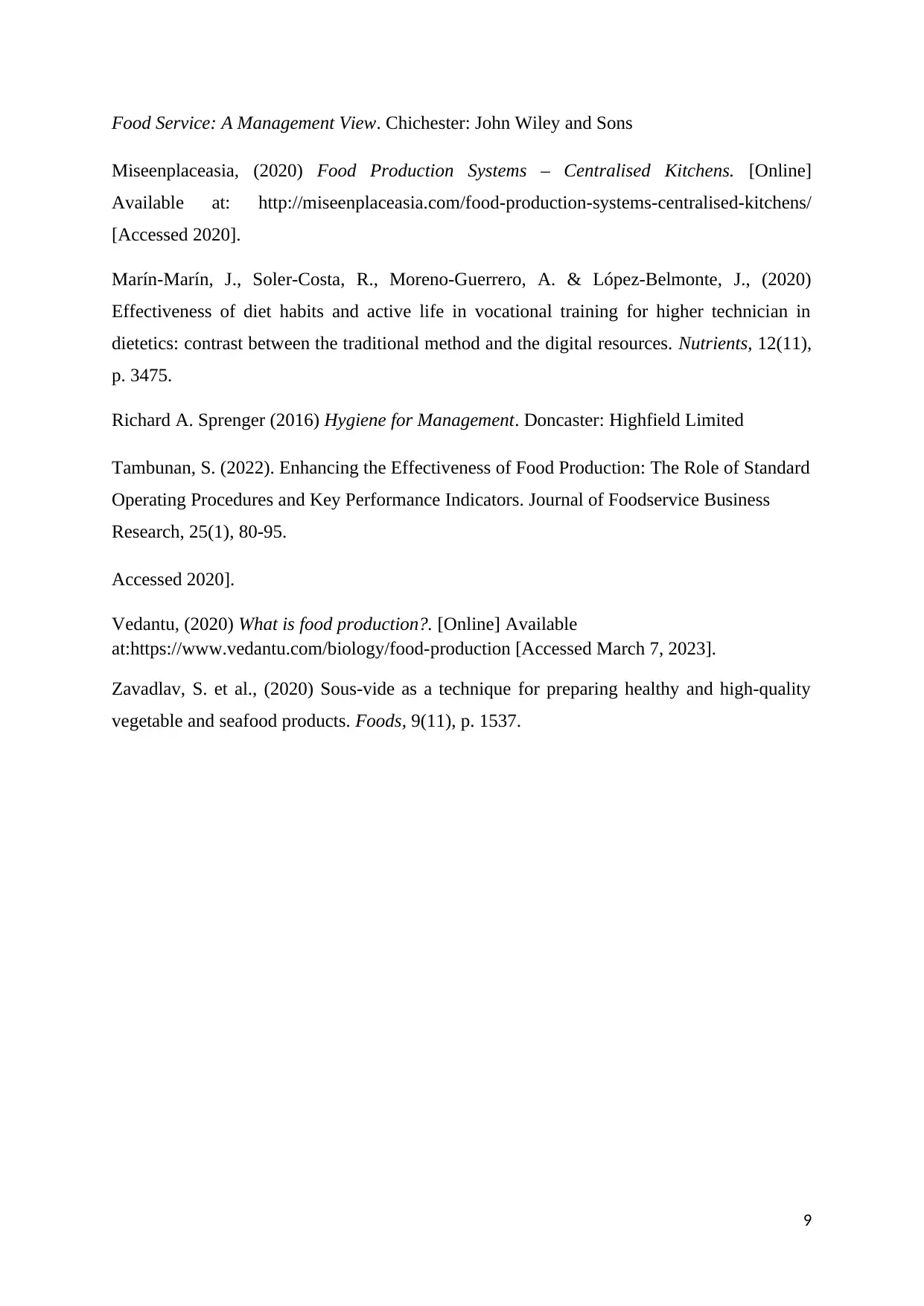
Food Service: A Management View. Chichester: John Wiley and Sons
Miseenplaceasia, (2020) Food Production Systems – Centralised Kitchens. [Online]
Available at: http://miseenplaceasia.com/food-production-systems-centralised-kitchens/
[Accessed 2020].
Marín-Marín, J., Soler-Costa, R., Moreno-Guerrero, A. & López-Belmonte, J., (2020)
Effectiveness of diet habits and active life in vocational training for higher technician in
dietetics: contrast between the traditional method and the digital resources. Nutrients, 12(11),
p. 3475.
Richard A. Sprenger (2016) Hygiene for Management. Doncaster: Highfield Limited
Tambunan, S. (2022). Enhancing the Effectiveness of Food Production: The Role of Standard
Operating Procedures and Key Performance Indicators. Journal of Foodservice Business
Research, 25(1), 80-95.
Accessed 2020].
Vedantu, (2020) What is food production?. [Online] Available
at:https://www.vedantu.com/biology/food-production [Accessed March 7, 2023].
Zavadlav, S. et al., (2020) Sous-vide as a technique for preparing healthy and high-quality
vegetable and seafood products. Foods, 9(11), p. 1537.
9
Miseenplaceasia, (2020) Food Production Systems – Centralised Kitchens. [Online]
Available at: http://miseenplaceasia.com/food-production-systems-centralised-kitchens/
[Accessed 2020].
Marín-Marín, J., Soler-Costa, R., Moreno-Guerrero, A. & López-Belmonte, J., (2020)
Effectiveness of diet habits and active life in vocational training for higher technician in
dietetics: contrast between the traditional method and the digital resources. Nutrients, 12(11),
p. 3475.
Richard A. Sprenger (2016) Hygiene for Management. Doncaster: Highfield Limited
Tambunan, S. (2022). Enhancing the Effectiveness of Food Production: The Role of Standard
Operating Procedures and Key Performance Indicators. Journal of Foodservice Business
Research, 25(1), 80-95.
Accessed 2020].
Vedantu, (2020) What is food production?. [Online] Available
at:https://www.vedantu.com/biology/food-production [Accessed March 7, 2023].
Zavadlav, S. et al., (2020) Sous-vide as a technique for preparing healthy and high-quality
vegetable and seafood products. Foods, 9(11), p. 1537.
9
⊘ This is a preview!⊘
Do you want full access?
Subscribe today to unlock all pages.

Trusted by 1+ million students worldwide
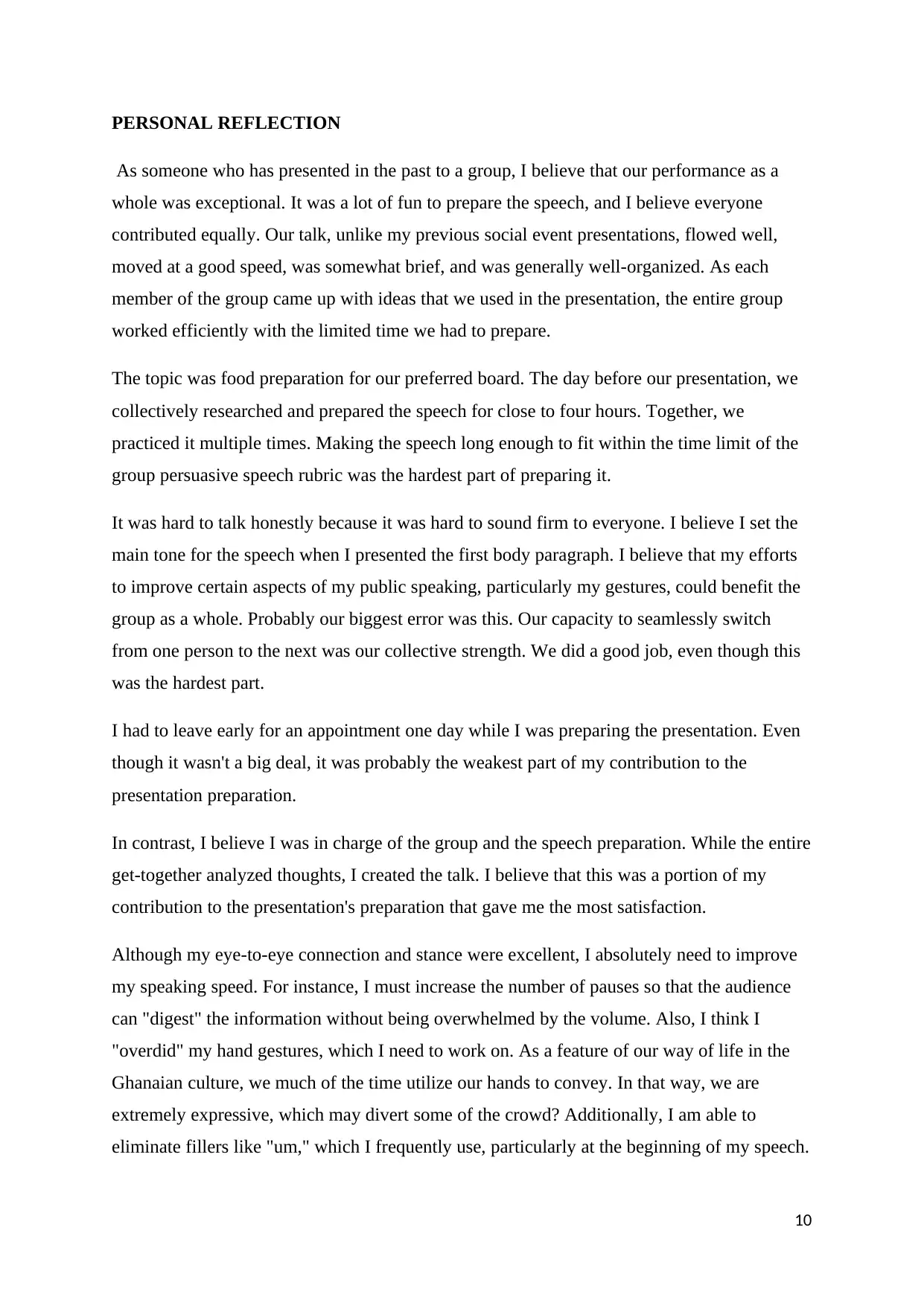
PERSONAL REFLECTION
As someone who has presented in the past to a group, I believe that our performance as a
whole was exceptional. It was a lot of fun to prepare the speech, and I believe everyone
contributed equally. Our talk, unlike my previous social event presentations, flowed well,
moved at a good speed, was somewhat brief, and was generally well-organized. As each
member of the group came up with ideas that we used in the presentation, the entire group
worked efficiently with the limited time we had to prepare.
The topic was food preparation for our preferred board. The day before our presentation, we
collectively researched and prepared the speech for close to four hours. Together, we
practiced it multiple times. Making the speech long enough to fit within the time limit of the
group persuasive speech rubric was the hardest part of preparing it.
It was hard to talk honestly because it was hard to sound firm to everyone. I believe I set the
main tone for the speech when I presented the first body paragraph. I believe that my efforts
to improve certain aspects of my public speaking, particularly my gestures, could benefit the
group as a whole. Probably our biggest error was this. Our capacity to seamlessly switch
from one person to the next was our collective strength. We did a good job, even though this
was the hardest part.
I had to leave early for an appointment one day while I was preparing the presentation. Even
though it wasn't a big deal, it was probably the weakest part of my contribution to the
presentation preparation.
In contrast, I believe I was in charge of the group and the speech preparation. While the entire
get-together analyzed thoughts, I created the talk. I believe that this was a portion of my
contribution to the presentation's preparation that gave me the most satisfaction.
Although my eye-to-eye connection and stance were excellent, I absolutely need to improve
my speaking speed. For instance, I must increase the number of pauses so that the audience
can "digest" the information without being overwhelmed by the volume. Also, I think I
"overdid" my hand gestures, which I need to work on. As a feature of our way of life in the
Ghanaian culture, we much of the time utilize our hands to convey. In that way, we are
extremely expressive, which may divert some of the crowd? Additionally, I am able to
eliminate fillers like "um," which I frequently use, particularly at the beginning of my speech.
10
As someone who has presented in the past to a group, I believe that our performance as a
whole was exceptional. It was a lot of fun to prepare the speech, and I believe everyone
contributed equally. Our talk, unlike my previous social event presentations, flowed well,
moved at a good speed, was somewhat brief, and was generally well-organized. As each
member of the group came up with ideas that we used in the presentation, the entire group
worked efficiently with the limited time we had to prepare.
The topic was food preparation for our preferred board. The day before our presentation, we
collectively researched and prepared the speech for close to four hours. Together, we
practiced it multiple times. Making the speech long enough to fit within the time limit of the
group persuasive speech rubric was the hardest part of preparing it.
It was hard to talk honestly because it was hard to sound firm to everyone. I believe I set the
main tone for the speech when I presented the first body paragraph. I believe that my efforts
to improve certain aspects of my public speaking, particularly my gestures, could benefit the
group as a whole. Probably our biggest error was this. Our capacity to seamlessly switch
from one person to the next was our collective strength. We did a good job, even though this
was the hardest part.
I had to leave early for an appointment one day while I was preparing the presentation. Even
though it wasn't a big deal, it was probably the weakest part of my contribution to the
presentation preparation.
In contrast, I believe I was in charge of the group and the speech preparation. While the entire
get-together analyzed thoughts, I created the talk. I believe that this was a portion of my
contribution to the presentation's preparation that gave me the most satisfaction.
Although my eye-to-eye connection and stance were excellent, I absolutely need to improve
my speaking speed. For instance, I must increase the number of pauses so that the audience
can "digest" the information without being overwhelmed by the volume. Also, I think I
"overdid" my hand gestures, which I need to work on. As a feature of our way of life in the
Ghanaian culture, we much of the time utilize our hands to convey. In that way, we are
extremely expressive, which may divert some of the crowd? Additionally, I am able to
eliminate fillers like "um," which I frequently use, particularly at the beginning of my speech.
10
Paraphrase This Document
Need a fresh take? Get an instant paraphrase of this document with our AI Paraphraser
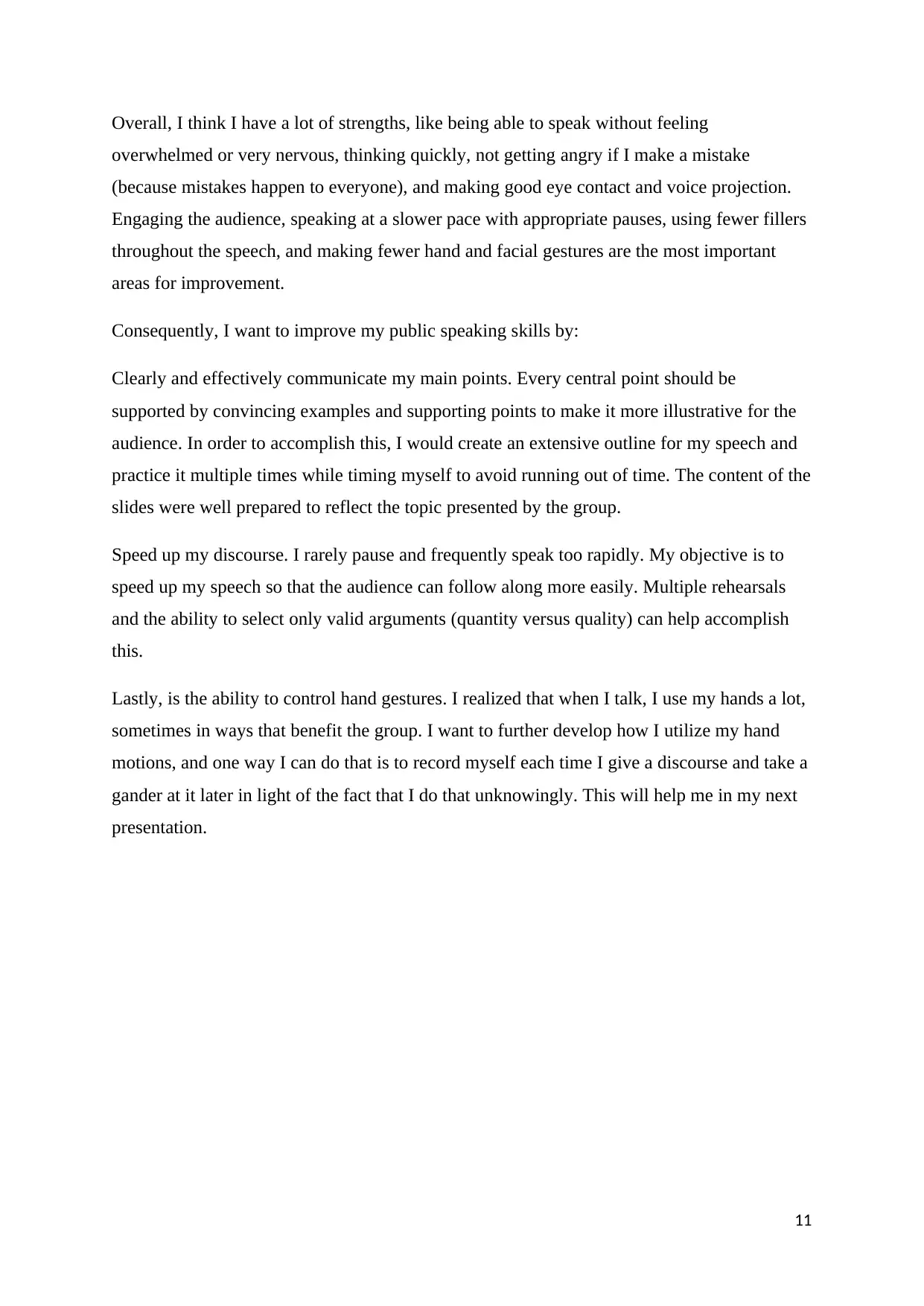
Overall, I think I have a lot of strengths, like being able to speak without feeling
overwhelmed or very nervous, thinking quickly, not getting angry if I make a mistake
(because mistakes happen to everyone), and making good eye contact and voice projection.
Engaging the audience, speaking at a slower pace with appropriate pauses, using fewer fillers
throughout the speech, and making fewer hand and facial gestures are the most important
areas for improvement.
Consequently, I want to improve my public speaking skills by:
Clearly and effectively communicate my main points. Every central point should be
supported by convincing examples and supporting points to make it more illustrative for the
audience. In order to accomplish this, I would create an extensive outline for my speech and
practice it multiple times while timing myself to avoid running out of time. The content of the
slides were well prepared to reflect the topic presented by the group.
Speed up my discourse. I rarely pause and frequently speak too rapidly. My objective is to
speed up my speech so that the audience can follow along more easily. Multiple rehearsals
and the ability to select only valid arguments (quantity versus quality) can help accomplish
this.
Lastly, is the ability to control hand gestures. I realized that when I talk, I use my hands a lot,
sometimes in ways that benefit the group. I want to further develop how I utilize my hand
motions, and one way I can do that is to record myself each time I give a discourse and take a
gander at it later in light of the fact that I do that unknowingly. This will help me in my next
presentation.
11
overwhelmed or very nervous, thinking quickly, not getting angry if I make a mistake
(because mistakes happen to everyone), and making good eye contact and voice projection.
Engaging the audience, speaking at a slower pace with appropriate pauses, using fewer fillers
throughout the speech, and making fewer hand and facial gestures are the most important
areas for improvement.
Consequently, I want to improve my public speaking skills by:
Clearly and effectively communicate my main points. Every central point should be
supported by convincing examples and supporting points to make it more illustrative for the
audience. In order to accomplish this, I would create an extensive outline for my speech and
practice it multiple times while timing myself to avoid running out of time. The content of the
slides were well prepared to reflect the topic presented by the group.
Speed up my discourse. I rarely pause and frequently speak too rapidly. My objective is to
speed up my speech so that the audience can follow along more easily. Multiple rehearsals
and the ability to select only valid arguments (quantity versus quality) can help accomplish
this.
Lastly, is the ability to control hand gestures. I realized that when I talk, I use my hands a lot,
sometimes in ways that benefit the group. I want to further develop how I utilize my hand
motions, and one way I can do that is to record myself each time I give a discourse and take a
gander at it later in light of the fact that I do that unknowingly. This will help me in my next
presentation.
11
1 out of 11
Related Documents
Your All-in-One AI-Powered Toolkit for Academic Success.
+13062052269
info@desklib.com
Available 24*7 on WhatsApp / Email
![[object Object]](/_next/static/media/star-bottom.7253800d.svg)
Unlock your academic potential
Copyright © 2020–2025 A2Z Services. All Rights Reserved. Developed and managed by ZUCOL.





